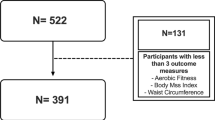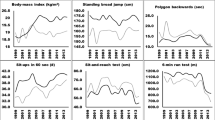Abstract
Background:
Adiposity, low aerobic fitness and low levels of activity are all associated with clustered cardiovascular disease risk in children and their high prevalence represents a major public health concern.
Objective:
The aim of this study is to investigate the relationship of objectively measured physical activity (PA) with motor skills (agility and balance), aerobic fitness and %body fat in young children.
Design:
This study is a cross-sectional and longitudinal analyses using mixed linear models. Longitudinal data were adjusted for baseline outcome parameters.
Subjects:
In all, 217 healthy preschool children (age 4–6 years, 48% boys) participated in this study.
Measurements:
PA (accelerometers), agility (obstacle course), dynamic balance (balance beam), aerobic fitness (20-m shuttle run) and %body fat (bioelectric impedance) at baseline and 9 months later.
Results:
PA was positively associated with both motor skills and aerobic fitness at baseline as well as with their longitudinal changes. Specifically, only vigorous, but not total or moderate PA, was related to changes in aerobic fitness. Higher PA was associated with less %body fat at baseline, but not with its change. Conversely, baseline motor skills, aerobic fitness or %body fat were not related to changes in PA.
Conclusion:
In young children, baseline PA was associated with improvements in motor skills and in aerobic fitness, an important determinant of cardiovascular risk.
This is a preview of subscription content, access via your institution
Access options
Subscribe to this journal
Receive 12 print issues and online access
$259.00 per year
only $21.58 per issue
Buy this article
- Purchase on Springer Link
- Instant access to full article PDF
Prices may be subject to local taxes which are calculated during checkout
Similar content being viewed by others
References
Andersen LB, Sardinha LB, Froberg K, Riddoch CJ, Page AS, Anderssen SA . Fitness, fatness and clustering of cardiovascular risk factors in children from Denmark, Estonia and Portugal: the European Youth Heart Study. Int J Pediatr Obes 2008; 3 (Suppl 1): 58–66.
McLure SA, Summerbell CD, Reilly JJ . Objectively measured habitual physical activity in a highly obesogenic environment. Child Care Health Dev 2009; 35: 369–375.
Tremblay MS, Shields M, Laviolette M, Craig CL, Janssen I, Gorber SC . Fitness of Canadian children and youth: results from the 2007-2009 Canadian Health Measures Survey. Health Rep 2010; 21: 7–20.
Tomkinson GR, Olds TS . Secular changes in pediatric aerobic fitness test performance: the global picture. Med Sport Sci 2007; 50: 46–66.
Barnett LM, van Beurden E, Morgan PJ, Brooks LO, Beard JR . Childhood motor skill proficiency as a predictor of adolescent physical activity. J Adolesc Health 2009; 44: 252–259.
Barnett LM, Van Beurden E, Morgan PJ, Brooks LO, Beard JR . Does childhood motor skill proficiency predict adolescent fitness? Med Sci Sports Exerc 2008; 40: 2137–2144.
Stodden DF, Goodway JD, Langendorfer SJ, Roberton MA, Rudisill ME, Garcia C et al. A Developmental Perspective on the Role of Motor Skill Competence in Physical Acitivity: An Emergent Relationship. Quest 2008; 60: 290–306.
Wrotniak BH, Epstein LH, Dorn JM, Jones KE, Kondilis VA . The relationship between motor proficiency and physical activity in children. Pediatrics 2006; 118: e1758–e1765.
Fisher A, Reilly JJ, Kelly LA, Montgomery C, Williamson A, Paton JY et al. Fundamental movement skills and habitual physical activity in young children. Med Sci Sports Exerc 2005; 37: 684–688.
Williams HG, Pfeiffer KA, O’Neill JR, Dowda M, McIver KL, Brown WH et al. Motor skill performance and physical activity in preschool children. Obesity (Silver Spring) 2008; 16: 1421–1426.
Dencker M, Bugge A, Hermansen B, Andersen LB . Objectively measured daily physical activity related to aerobic fitness in young children. J Sports Sci 2010; 28: 139–145.
Ruiz JR, Rizzo NS, Hurtig-Wennlof A, Ortega FB, Warnberg J, Sjostrom M . Relations of total physical activity and intensity to fitness and fatness in children: the European Youth Heart Study. Am J Clin Nutr 2006; 84: 299–303.
Photiou A, Anning JH, Meszaros J, Vajda I, Meszaros Z, Sziva A et al. Lifestyle, body composition, and physical fitness changes in Hungarian school boys (1975–2005). Res Q Exerc Sport 2008; 79: 166–173.
Baquet G, Twisk JW, Kemper HC, Van Praagh E, Berthoin S . Longitudinal follow-up of fitness during childhood: interaction with physical activity. Am J Hum Biol 2006; 18: 51–58.
Klesges RC, Klesges LM, Eck LH, Shelton ML . A longitudinal analysis of accelerated weight gain in preschool children. Pediatrics 1995; 95: 126–130.
Moore LL, Nguyen US, Rothman KJ, Cupples LA, Ellison RC . Preschool physical activity level and change in body fatness in young children. The Framingham Children's Study. Am J Epidemiol 1995; 142: 982–988.
Jimenez-Pavon D, Kelly J, Reilly JJ . Associations between objectively measured habitual physical activity and adiposity in children and adolescents: systematic review. Int J Pediatr Obes 2010; 5: 3–18.
Metcalf BS, Voss LD, Hosking J, Jeffery AN, Wilkin TJ . Physical activity at the government-recommended level and obesity-related health outcomes: a longitudinal study (Early Bird 37). Arch Dis Child 2008; 93: 772–777.
Niederer I, Kriemler S, Zahner L, Burgi F, Ebenegger V, Hartmann T et al. Influence of a lifestyle intervention in preschool children on physiological and psychological parameters (Ballabeina): study design of a cluster randomized controlled trial. BMC Public Health 2009; 9: 94.
de Vries SI, Bakker I, Hopman-Rock M, Hirasing RA, van Mechelen W . Clinimetric review of motion sensors in children and adolescents. J Clin Epidemiol 2006; 59: 670–680.
Pate RR, Almeida MJ, McIver KL, Pfeiffer KA, Dowda M . Validation and calibration of an accelerometer in preschool children. Obesity (Silver Spring) 2006; 14: 2000–2006.
Trost SG, Pate RR, Freedson PS, Sallis JF, Taylor WC . Using objective physical activity measures with youth: how many days of monitoring are needed? Med Sci Sports Exerc 2000; 32: 426–431.
Baquet G, Stratton G, Van Praagh E, Berthoin S . Improving physical activity assessment in prepubertal children with high-frequency accelerometry monitoring: a methodological issue. Prev Med 2007; 44: 143–147.
Ortega FB, Ruiz JR, Castillo MJ, Sjostrom M . Physical fitness in childhood and adolescence: a powerful marker of health. Int J Obes (Lond) 2008; 32: 1–11.
Molnar D, Livingstone B . Physical activity in relation to overweight and obesity in children and adolescents. Eur J Pediatr 2000; 159 (Suppl 1): S45–S55.
Sheppard JM, Young WB . Agility literature review: classifications, training and testing. J Sports Sci 2006; 24: 919–932.
Vogt U . Die Motorik 3-bis 6jähriger Kinder: Ihre Abhängigkeit Vom Biologischen Entwicklungsstand und Sozialen Umweltfaktoren. Zugl: Diss Berlin-West, Hofmann, Schorndorf, 1978.
Kunz T . Weniger Unfälle Durch Bewegung : Mit Bewegungsspielen Gegen Unfälle und Gesundheitsschäden Bei Kindergartenkindern. Verlag Karl Hofmann: Schorndorf, 1993.
Malina RM, Bouchard C, Bar-Or O . Growth, Maturation, and Physical Activity, 2nd edn. Human Kinetics Books: Champaign, IL., 2004.
Leger LA, Mercier D, Gadoury C, Lambert J . The multistage 20 metre shuttle run test for aerobic fitness. J Sports Sci 1988; 6: 93–101.
Mahoney C . 20-MST and PWC170 validity in non-Caucasian children in the UK. Br J Sports Med 1992; 26: 45–47.
van Mechelen W, Hlobil H, Kemper HC . Validation of two running tests as estimates of maximal aerobic power in children. Eur J Appl Physiol Occup Physiol 1986; 55: 503–506.
Kriemler S, Puder J, Zahner L, Roth R, Braun-Fahrlander C, Bedogni G . Cross-validation of bioelectrical impedance analysis for the assessment of body composition in a representative sample of 6- to 13-year-old children. Eur J Clin Nutr 2009; 63: 619–626.
Loue S . Assessing Race, Ethnicity, and Gender in Health. Springer: New York, US, 2006.
Lasserre AM, Chiolero A, Cachat F, Paccaud F, Bovet P . Overweight in Swiss children and associations with children's and parents’ characteristics. Obesity (Silver Spring) 2007; 15: 2912–2919.
Huang YC, Malina RM . Physical activity and health-related physical fitness in Taiwanese adolescents. J Physiol Anthropol Appl Human Sci 2002; 21: 11–19.
Hussey J, Bell C, Bennett K, O’Dwyer J, Gormley J . Relationship between the intensity of physical activity, inactivity, cardiorespiratory fitness and body composition in 7-10-year-old Dublin children. Br J Sports Med 2007; 41: 311–316.
Gutin B, Yin Z, Humphries MC, Barbeau P . Relations of moderate and vigorous physical activity to fitness and fatness in adolescents. Am J Clin Nutr 2005; 81: 746–750.
Dencker M, Thorsson O, Karlsson MK, Linden C, Svensson J, Wollmer P et al. Daily physical activity and its relation to aerobic fitness in children aged 8–11 years. Eur J Appl Physiol 2006; 96: 587–592.
Dencker M, Thorsson O, Karlsson MK, Linden C, Wollmer P, Andersen LB . Daily physical activity related to aerobic fitness and body fat in an urban sample of children. Scand J Med Sci Sports 2008; 18: 728–735.
Strong WB, Malina RM, Blimkie CJ, Daniels SR, Dishman RK, Gutin B et al. Evidence based physical activity for school-age youth. J Pediatr 2005; 146: 732–737.
Bailey RC, Olson J, Pepper SL, Porszasz J, Barstow TJ, Cooper DM . The level and tempo of children's physical activities: an observational study. Med Sci Sports Exerc 1995; 27: 1033–1041.
Lopes VP, Rodrigues LP, Maia JA, Malina RM . Motor coordination as predictor of physical activity in childhood. Scand J Med Sci Sports 2010; e-pub ahead of print 11 March 2010, doi:10.1111/j.1600-0838.2009.01027.x.
McKenzie TL, Sallis JF, Broyles SL, Zive MM, Nader PR, Berry CC et al. Childhood movement skills: predictors of physical activity in Anglo American and Mexican American adolescents? Res Q Exerc Sport 2002; 73: 238–244.
Burton AW, Miller DE . Movement skill assessment. Human Kinetics: Champaign, IL, 1998.
Metcalf BS, Hosking J, Jeffery AN, Voss LD, Henley W, Wilkin TJ . Fatness leads to inactivity, but inactivity does not lead to fatness: a longitudinal study in children (EarlyBird 45). Arch Dis Child 2010; e-pub ahead of print 23 June 2010, doi:10.1136/adc.2009.175927.
Ekelund U, Brage S, Besson H, Sharp S, Wareham NJ . Time spent being sedentary and weight gain in healthy adults: reverse or bidirectional causality? Am J Clin Nutr 2008; 88: 612–617.
Wong WW, Butte NF, Hergenroeder AC, Hill RB, Stuff JE, Smith EO . Are basal metabolic rate prediction equations appropriate for female children and adolescents? J Appl Physiol 1996; 81: 2407–2414.
Acknowledgements
We thank all children, their parents, school teachers and the respective school health services for their participation and help in the study. The study was principally supported by Swiss National Science Foundation (Grant 3200B0-116837) and Health Promotion Switzerland (Project 2104). Additional funding was obtained from a research award for Interdisciplinary Research from the University of Lausanne, a Takeda research award, the Wyeth Foundation for the Health of children and adolescents, the Freie Akademische Gesellschaft and an unrestricted educational grant from Nestlé. Trial Registration: clinicaltrials.gov NCT00674544.
Author information
Authors and Affiliations
Corresponding author
Ethics declarations
Competing interests
The authors declare no conflict of interest.
Rights and permissions
About this article
Cite this article
Bürgi, F., Meyer, U., Granacher, U. et al. Relationship of physical activity with motor skills, aerobic fitness and body fat in preschool children: a cross-sectional and longitudinal study (Ballabeina). Int J Obes 35, 937–944 (2011). https://doi.org/10.1038/ijo.2011.54
Received:
Revised:
Accepted:
Published:
Issue Date:
DOI: https://doi.org/10.1038/ijo.2011.54
Keywords
This article is cited by
-
Longitudinal associations of movement behaviours with body composition and physical fitness from 4 to 9 years of age: structural equation and mediation analysis with compositional data
International Journal of Behavioral Nutrition and Physical Activity (2023)
-
Kin ball to promote the motor development of students with special educational needs: effects of an intervention programme
Sport Sciences for Health (2023)
-
Through the Looking Glass: A Systematic Review of Longitudinal Evidence, Providing New Insight for Motor Competence and Health
Sports Medicine (2022)
-
Trajectories of objectively measured physical activity and childhood overweight: longitudinal analysis of the IDEFICS/I.Family cohort
International Journal of Behavioral Nutrition and Physical Activity (2021)
-
Children’s physical activity level and sedentary behaviour in Norwegian early childhood education and care: effects of a staff-led cluster-randomised controlled trial
BMC Public Health (2020)



